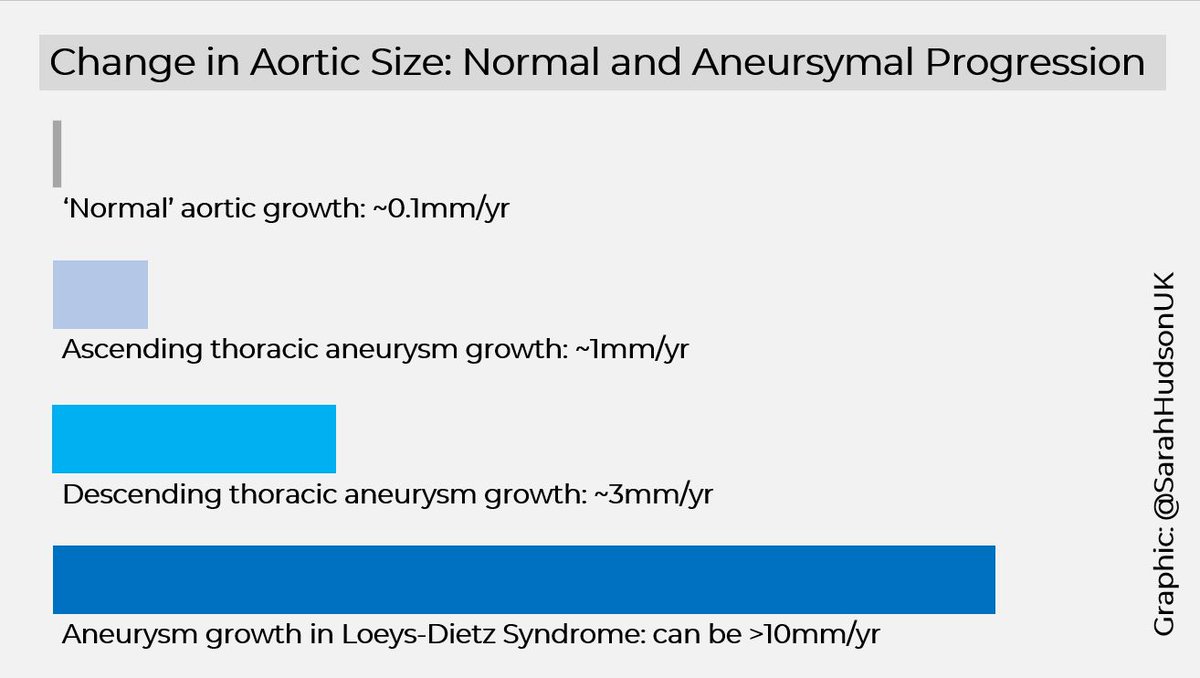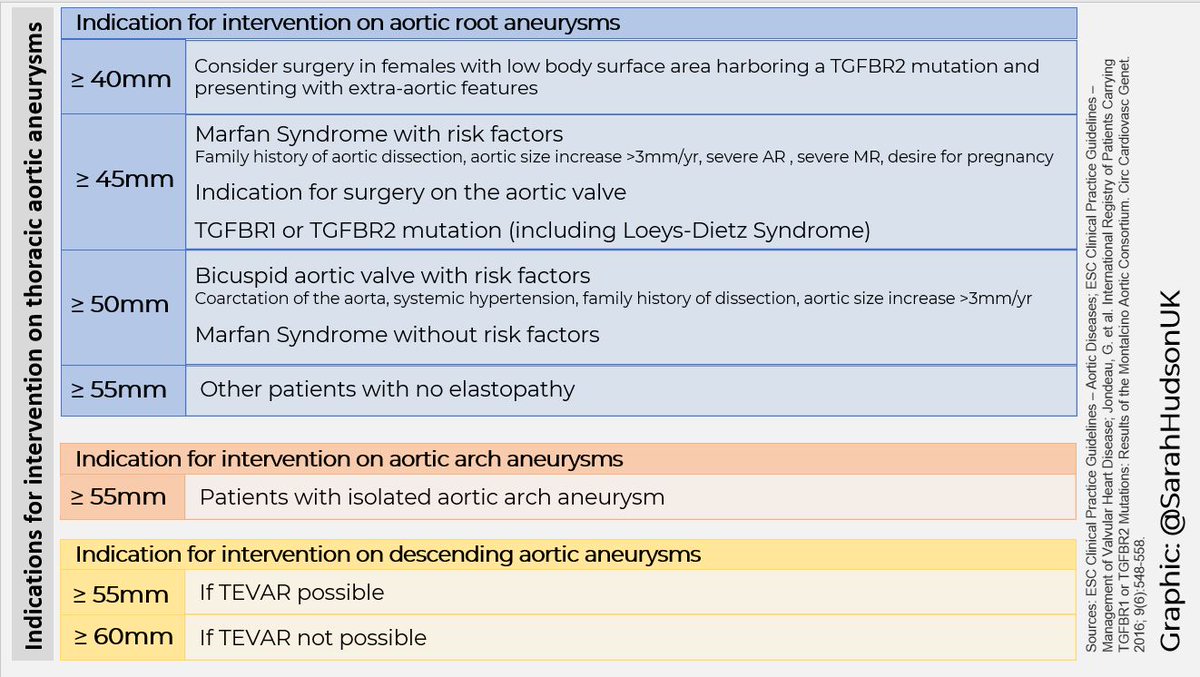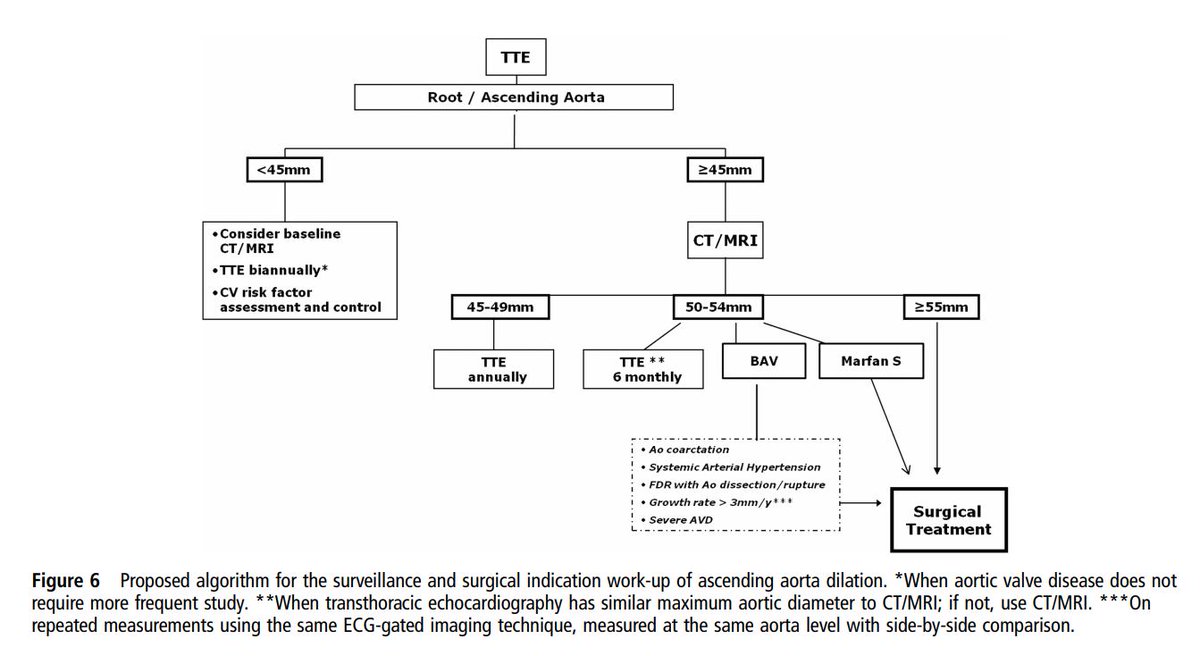Incidental finding of dilated aortic root/ thoracic aortic aneurysm – what should you do?
Fully-referenced thread covering when to intervene, how to follow up and what else to think about
1/n
Fully-referenced thread covering when to intervene, how to follow up and what else to think about
1/n
To start with the basics: the size of the aortic root varies based on sex, height, weight and age, so these details are required to put a basic figure into context.
https://www.ncbi.nlm.nih.gov/pmc/articles/PMC3462295/">https://www.ncbi.nlm.nih.gov/pmc/artic... 2/n
https://www.ncbi.nlm.nih.gov/pmc/articles/PMC3462295/">https://www.ncbi.nlm.nih.gov/pmc/artic... 2/n
The commonly used nomogram to work out if an aortic root is dilated based on body surface area and age is based on the work of Roman et al, and is quoted in the ASE/EACVI 2015 guidelines
https://www.asecho.org/wp-content/uploads/2015/01/2015_Thoracic-Aorta.pdf">https://www.asecho.org/wp-conten...
3/n
https://www.asecho.org/wp-content/uploads/2015/01/2015_Thoracic-Aorta.pdf">https://www.asecho.org/wp-conten...
3/n
The authors of a recent JACC paper stated that they used a criterion of 4cm for defining an aneurysm and for clinical aortic follow up to begin.
https://www.onlinejacc.org/content/76/2/201">https://www.onlinejacc.org/content/7... 4/n
https://www.onlinejacc.org/content/76/2/201">https://www.onlinejacc.org/content/7... 4/n
Observational data suggests the median size at the time of rupture or dissection is:
 https://abs.twimg.com/emoji/v2/... draggable="false" alt="▪️" title="Schwarzes kleines Quadrat" aria-label="Emoji: Schwarzes kleines Quadrat"> 60mm for ascending thoracic aneurysms
https://abs.twimg.com/emoji/v2/... draggable="false" alt="▪️" title="Schwarzes kleines Quadrat" aria-label="Emoji: Schwarzes kleines Quadrat"> 60mm for ascending thoracic aneurysms
 https://abs.twimg.com/emoji/v2/... draggable="false" alt="▪️" title="Schwarzes kleines Quadrat" aria-label="Emoji: Schwarzes kleines Quadrat"> 72mm for descending thoracic aneurysms.
https://abs.twimg.com/emoji/v2/... draggable="false" alt="▪️" title="Schwarzes kleines Quadrat" aria-label="Emoji: Schwarzes kleines Quadrat"> 72mm for descending thoracic aneurysms.
#secd19034710e1299">https://www.jtcvs.org/article/S0022-5223(97)70360-X/fulltext #secd19034710e1299">https://www.jtcvs.org/article/S... 5/n
#secd19034710e1299">https://www.jtcvs.org/article/S0022-5223(97)70360-X/fulltext #secd19034710e1299">https://www.jtcvs.org/article/S... 5/n
The rate of aortic expansion in ‘normal’ aorta is~0.9mm in men/0.7mm in women for each decade
Aneursyms of the ascending aorta tend to grow at a rate of~1mm/yr
Aneursyms of the descending aorta grow faster-~3mm/yr
Familial aneurysms: even faster
https://www.escardio.org/Guidelines/Clinical-Practice-Guidelines/Aortic-Diseases">https://www.escardio.org/Guideline... 6/n
Aneursyms of the ascending aorta tend to grow at a rate of~1mm/yr
Aneursyms of the descending aorta grow faster-~3mm/yr
Familial aneurysms: even faster
https://www.escardio.org/Guidelines/Clinical-Practice-Guidelines/Aortic-Diseases">https://www.escardio.org/Guideline... 6/n
So at what point is intervention needed on a thoracic aortic aneurysm?
ESC guidelines are summarised in the image below.
Links to the references:
https://www.escardio.org/Guidelines/Clinical-Practice-Guidelines/Aortic-Diseases
https://www.escardio.org/Guideline... href=" https://www.escardio.org/Guidelines/Clinical-Practice-Guidelines/Valvular-Heart-Disease-Management-of
https://www.escardio.org/Guideline... href=" https://pubmed.ncbi.nlm.nih.gov/27879313/ ">https://pubmed.ncbi.nlm.nih.gov/27879313/... 7/n
ESC guidelines are summarised in the image below.
Links to the references:
https://www.escardio.org/Guidelines/Clinical-Practice-Guidelines/Aortic-Diseases
And if surgery isn’t needed, how should you follow up?
ESC guidelines give no prescriptive advice.
Factors to be considered include:
 https://abs.twimg.com/emoji/v2/... draggable="false" alt="▪️" title="Schwarzes kleines Quadrat" aria-label="Emoji: Schwarzes kleines Quadrat"> Size of aneurysm
https://abs.twimg.com/emoji/v2/... draggable="false" alt="▪️" title="Schwarzes kleines Quadrat" aria-label="Emoji: Schwarzes kleines Quadrat"> Size of aneurysm
 https://abs.twimg.com/emoji/v2/... draggable="false" alt="▪️" title="Schwarzes kleines Quadrat" aria-label="Emoji: Schwarzes kleines Quadrat"> Age of pt/relevance of radiation exposure
https://abs.twimg.com/emoji/v2/... draggable="false" alt="▪️" title="Schwarzes kleines Quadrat" aria-label="Emoji: Schwarzes kleines Quadrat"> Age of pt/relevance of radiation exposure
 https://abs.twimg.com/emoji/v2/... draggable="false" alt="▪️" title="Schwarzes kleines Quadrat" aria-label="Emoji: Schwarzes kleines Quadrat"> Location of aneurysm
https://abs.twimg.com/emoji/v2/... draggable="false" alt="▪️" title="Schwarzes kleines Quadrat" aria-label="Emoji: Schwarzes kleines Quadrat"> Location of aneurysm
 https://abs.twimg.com/emoji/v2/... draggable="false" alt="▪️" title="Schwarzes kleines Quadrat" aria-label="Emoji: Schwarzes kleines Quadrat"> Risk factors (bicuspid valve, genetic syndromes) 8/n
https://abs.twimg.com/emoji/v2/... draggable="false" alt="▪️" title="Schwarzes kleines Quadrat" aria-label="Emoji: Schwarzes kleines Quadrat"> Risk factors (bicuspid valve, genetic syndromes) 8/n
ESC guidelines give no prescriptive advice.
Factors to be considered include:
A 2014 review in @Heart_BMJ suggested follow-up of root/ascending aortic aneurysms as described in the diagram below, with TTE every 2 yrs when <45mm increasing to yearly when 45-49mm and 6 months when 50-54mm
https://heart.bmj.com/content/100/12/909.info">https://heart.bmj.com/content/1... 9/n
https://heart.bmj.com/content/100/12/909.info">https://heart.bmj.com/content/1... 9/n
A 2016 paper suggested for 40-50mm root/ascending aneurysms:
 https://abs.twimg.com/emoji/v2/... draggable="false" alt="▪️" title="Schwarzes kleines Quadrat" aria-label="Emoji: Schwarzes kleines Quadrat"> Initially image whole aorta,then repeat in 1 yr
https://abs.twimg.com/emoji/v2/... draggable="false" alt="▪️" title="Schwarzes kleines Quadrat" aria-label="Emoji: Schwarzes kleines Quadrat"> Initially image whole aorta,then repeat in 1 yr
 https://abs.twimg.com/emoji/v2/... draggable="false" alt="▪️" title="Schwarzes kleines Quadrat" aria-label="Emoji: Schwarzes kleines Quadrat"> If diameter stable,repeat imaging in 18-24months
https://abs.twimg.com/emoji/v2/... draggable="false" alt="▪️" title="Schwarzes kleines Quadrat" aria-label="Emoji: Schwarzes kleines Quadrat"> If diameter stable,repeat imaging in 18-24months
 https://abs.twimg.com/emoji/v2/... draggable="false" alt="▪️" title="Schwarzes kleines Quadrat" aria-label="Emoji: Schwarzes kleines Quadrat"> If aortic growth >2mm, repeat annually
https://abs.twimg.com/emoji/v2/... draggable="false" alt="▪️" title="Schwarzes kleines Quadrat" aria-label="Emoji: Schwarzes kleines Quadrat"> If aortic growth >2mm, repeat annually
 https://abs.twimg.com/emoji/v2/... draggable="false" alt="▪️" title="Schwarzes kleines Quadrat" aria-label="Emoji: Schwarzes kleines Quadrat"> If familial/CTD aneurysm,image annually
https://abs.twimg.com/emoji/v2/... draggable="false" alt="▪️" title="Schwarzes kleines Quadrat" aria-label="Emoji: Schwarzes kleines Quadrat"> If familial/CTD aneurysm,image annually
https://academic.oup.com/ejcts/article/50/3/562/2197495">https://academic.oup.com/ejcts/art... 10/n
https://academic.oup.com/ejcts/article/50/3/562/2197495">https://academic.oup.com/ejcts/art... 10/n
A 2020 JACC paper suggests for routine small to moderate ascending aortic aneurysms, repeat CT scanning should be no more often than every 2 to 3 years
https://www.onlinejacc.org/content/76/2/201">https://www.onlinejacc.org/content/7... 11/n
https://www.onlinejacc.org/content/76/2/201">https://www.onlinejacc.org/content/7... 11/n
And other than surveillance, what else should you do?
For pts with Marfans, betablockers/losartan may slow rate of dilation.
While there is no evidence,it is also common practice to use these meds in pts with dilated aortic root & a bicuspid valve
https://www.escardio.org/Guidelines/Clinical-Practice-Guidelines/Valvular-Heart-Disease-Management-of">https://www.escardio.org/Guideline... 12/n
For pts with Marfans, betablockers/losartan may slow rate of dilation.
While there is no evidence,it is also common practice to use these meds in pts with dilated aortic root & a bicuspid valve
https://www.escardio.org/Guidelines/Clinical-Practice-Guidelines/Valvular-Heart-Disease-Management-of">https://www.escardio.org/Guideline... 12/n
General advice for all pts with dilated aortic root/thoracic aortic aneurysm:
1) Smoking cessation
2) Manage BP to lowest point patients can tolerate without adverse effects (BB/ARB/ACE)
3) Treat cholesterol – target LDL <70mg/dL
https://www.onlinejacc.org/content/accj/55/14/e27.full.pdf">https://www.onlinejacc.org/content/a...
13/n
1) Smoking cessation
2) Manage BP to lowest point patients can tolerate without adverse effects (BB/ARB/ACE)
3) Treat cholesterol – target LDL <70mg/dL
https://www.onlinejacc.org/content/accj/55/14/e27.full.pdf">https://www.onlinejacc.org/content/a...
13/n
Other things to think about:
1) The accuracy of the measurements being used – a topic all by itself – see https://www.onlinejacc.org/content/76/2/201
2)">https://www.onlinejacc.org/content/7... Family screening if bicuspid aortic valve
3) Pregnancy if relevant – see https://www.ahajournals.org/doi/10.1161/circulationaha.116.021594
14/14">https://www.ahajournals.org/doi/10.11...
1) The accuracy of the measurements being used – a topic all by itself – see https://www.onlinejacc.org/content/76/2/201
2)">https://www.onlinejacc.org/content/7... Family screening if bicuspid aortic valve
3) Pregnancy if relevant – see https://www.ahajournals.org/doi/10.1161/circulationaha.116.021594
14/14">https://www.ahajournals.org/doi/10.11...

 Read on Twitter
Read on Twitter
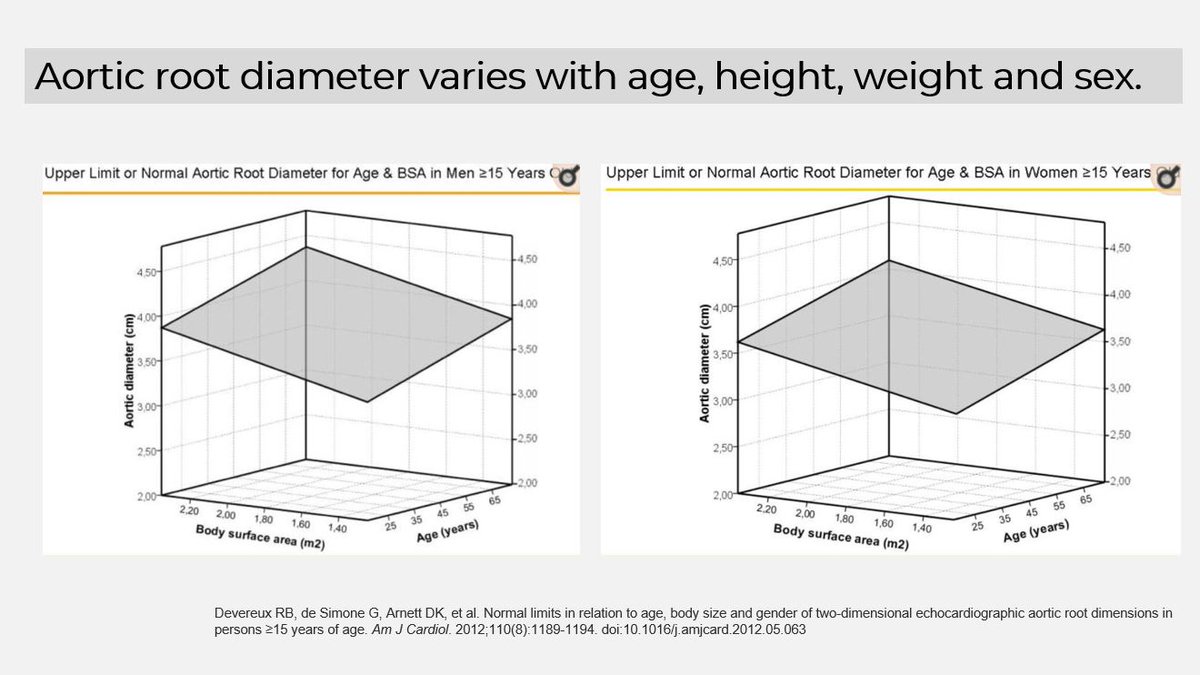
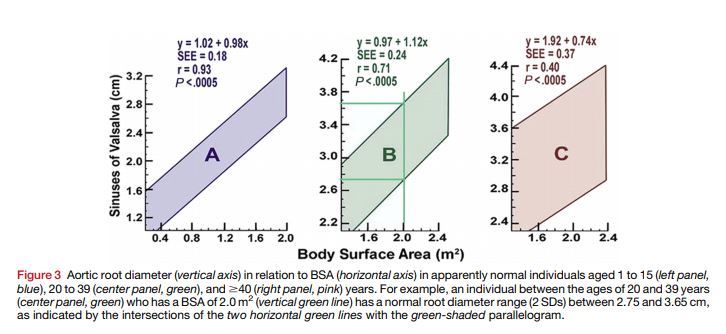
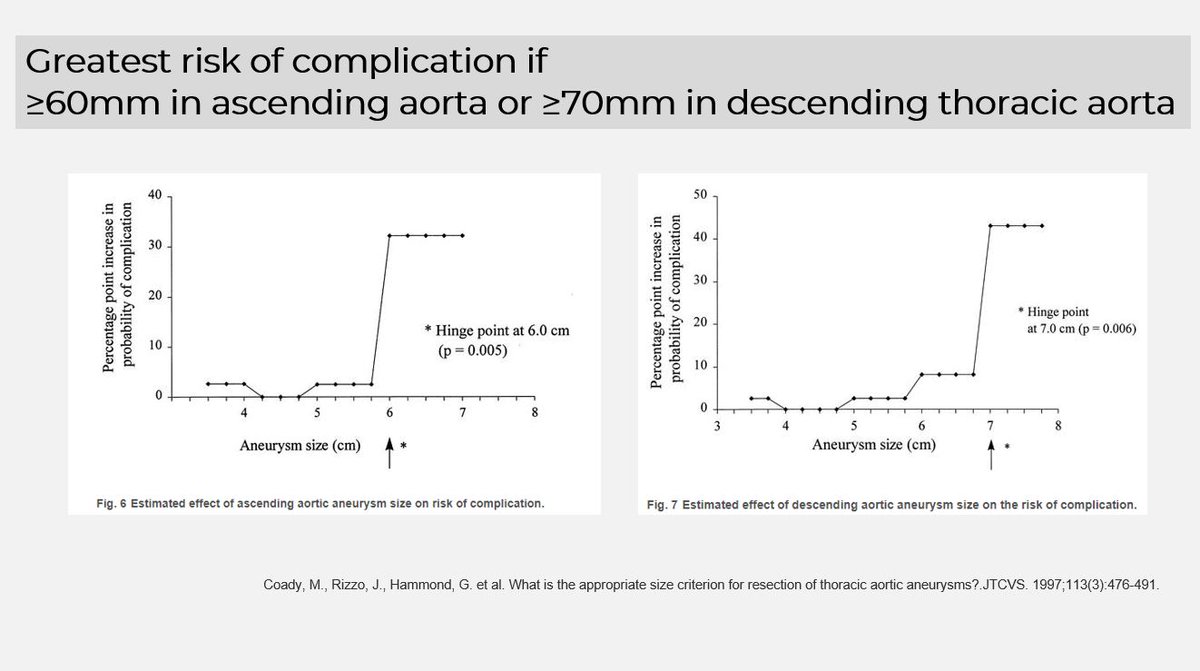 60mm for ascending thoracic aneurysms https://abs.twimg.com/emoji/v2/... draggable="false" alt="▪️" title="Schwarzes kleines Quadrat" aria-label="Emoji: Schwarzes kleines Quadrat"> 72mm for descending thoracic aneurysms. https://www.jtcvs.org/article/S... 5/n" title="Observational data suggests the median size at the time of rupture or dissection is:https://abs.twimg.com/emoji/v2/... draggable="false" alt="▪️" title="Schwarzes kleines Quadrat" aria-label="Emoji: Schwarzes kleines Quadrat"> 60mm for ascending thoracic aneurysms https://abs.twimg.com/emoji/v2/... draggable="false" alt="▪️" title="Schwarzes kleines Quadrat" aria-label="Emoji: Schwarzes kleines Quadrat"> 72mm for descending thoracic aneurysms. https://www.jtcvs.org/article/S... 5/n" class="img-responsive" style="max-width:100%;"/>
60mm for ascending thoracic aneurysms https://abs.twimg.com/emoji/v2/... draggable="false" alt="▪️" title="Schwarzes kleines Quadrat" aria-label="Emoji: Schwarzes kleines Quadrat"> 72mm for descending thoracic aneurysms. https://www.jtcvs.org/article/S... 5/n" title="Observational data suggests the median size at the time of rupture or dissection is:https://abs.twimg.com/emoji/v2/... draggable="false" alt="▪️" title="Schwarzes kleines Quadrat" aria-label="Emoji: Schwarzes kleines Quadrat"> 60mm for ascending thoracic aneurysms https://abs.twimg.com/emoji/v2/... draggable="false" alt="▪️" title="Schwarzes kleines Quadrat" aria-label="Emoji: Schwarzes kleines Quadrat"> 72mm for descending thoracic aneurysms. https://www.jtcvs.org/article/S... 5/n" class="img-responsive" style="max-width:100%;"/>
